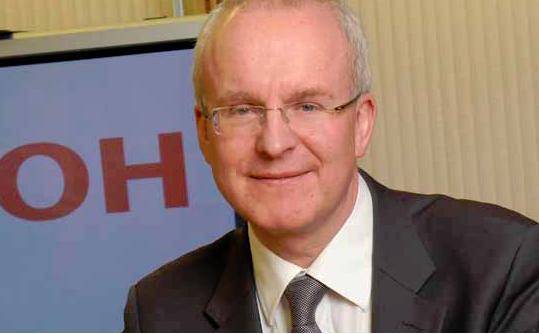
Ricoh executive vice president Ian Winham makes frequent trips down the acquisition road. Here, he offers insights on what works, and a novel idea on what’s next.
Maybe it’s time for Google to purchase a carmaker.
As autos morph into entertaining route finders surrounded by metal and rubber, why shouldn’t the pre-eminent maker of search engines step behind the wheel? Google is amassing the ultimate database of the people, places and things that are the raw material for digitally boosted locomotion. It demonstrated the potential itselfwhen its technology piloted seven driverless vehicles around California recently.
Add the timely diagnostic under-the-bonnet information that onboard computing can deliver, and it’s a case of move over Batmobile, hello to the Searchmobile.
This futuristic view of Google might be a fanciful notion but it illustrates that now, more than ever, companies should focus their merger and acquisition strategy on long-term synergies. The infusion of information technology into all facets of commerce and production is causing previously separate industries to butt into one another like never before. IT and transport will converge. So will IT and the power industry, as internet companies like Cisco and industrial stalwarts like ABB chase the smart grid business. My company, Ricoh, knows convergence well and facilitates it. Our customers personify it—they continually produce, access, display and store all sorts of ‘documents’, be they word, picture or sound.
IT’s importance will continue to trigger acquisitions across industries, much as it has done in the media business where screens of all shapes and sizes, including the iconic television and the ubiquitous mobile phone, now display the internet. Thus Google picked up YouTube in 2006. Cisco has over the years made myriad smart acquisitions to help it expand into a multimedia company. Its purchase of Tandberg and of flip phone company Pure Digital, for instance, helped broaden its reach in video communications.
Convergence has even banished the old taboo against software companies selling hardware and vice versa. Oracle bought Sun Microsystems, Intel purchased computer security firm McAfee, Microsoft sells games consoles, and Google itself sells mobile phones.
Many acquisitions will centre on the shift to a services-based business model, as with Dell’s November purchase of software-as-a-service firm Boomi. Ricoh, traditionally an office equipment company, has also been focusing on accelerating its shift towards a service orientated business model, an important step to support CIOs with managing information across the business.
A cautionary note however: meshing two companies might make absolute business sense, but beware of culture clashes. Different cultures clearly represent different sensitivities, and understanding the benefits of different cultures is not about changing them, but about knowing where they fit and how they will work in your business. As part of the $21 billion Tokyo-based Ricoh Company, Ricoh Europe is inherently aware of this. Our cross-border acquisitions of US and Swedish distributors IKON Office Solutions and Carl Lamm have worked because we devoted considerable attention to the integration of people.
The mere combination of digital endeavours alone is not magic. The eBay-Skype hook-up unravelled as eBay eventually acknowledged “limited synergies” before selling most of Skype in 2009 for less than what it paid for it in 2005. AOL and Time Warner split late last year as their market value plunged to about 10 per cent of what it once was during the10-year marriage. And if merging companies don’t link customer value into their long-term vision, their union won’t last.
These failures help reaffirm a platitude of sound M&A: have a clear reason for the acquisition and how it will add business value. Factors like geographic expansion, supply chain efficiencies, access to raw materials and energy conservation are as important today as ever. By bringing IKON and Carl Lamm into our fold we’ve strengthened the downstream side of our supply chain by supplanting competitors’ office equipment with the Ricoh brand and adding new skills such as production printing and IT network and support services.
Acquisition can also serve as a defensive manoeuvre to box out new competition when necessary, but generally, defensive acquisitions do not yield great returns, so practice them judiciously. One other caution for any acquisition: don’t underestimate the effort you’ll put into due diligence, especially sorting details with pension funds. Airlines BA and Iberia only recently cleared pension hurdles in their protracted effort to merge.
Even when the ‘golden rules’ are followed throughout the process, the benefits of an acquisition need to be tracked and measured. It is a ‘given’ that determining the strategic rationale before an acquisition is a key focus, but at Ricoh we also devote significant resources to analysing the realisation of benefits during and after a deal has been put in place. This enables us to ensure that key objectives are being achieved every step of the way.
With all this in mind, next time an automaker is up for grabs, maybe Google’s Eric Schmidt and Sergey Brin should consider it. They missed a chance in 2007 when Chrysler sold for $7.4 billion, not much more than the nearly $5 billion Google had just spent acquiring YouTube and ad company DoubleClick. With an automobile acquisition, Google could take the Ricoh approach to M&A, focusing on companies that add customer benefit and business value. Google could sell ‘cars-as-a-service’. A-la mobile phones, it could provide the car free for two years in exchange for a contract covering electric battery charging, unlimited miles, maintenance reminders, and all the travelling entertainment and mapping a user desires. With such a move, the phrase ‘information superhighway’ would acquire a whole new meaning.
Ian Winham is executive vice president and chief financial officer of Ricoh Europe. Ricoh works with organisations around the world to modernise work environments and optimise document efficiency. http://www.ricoh.com












